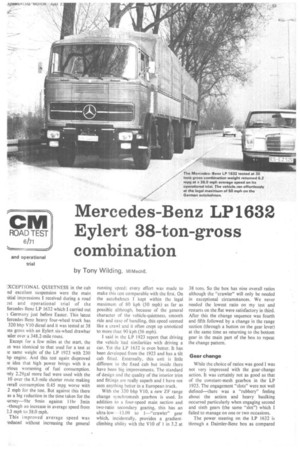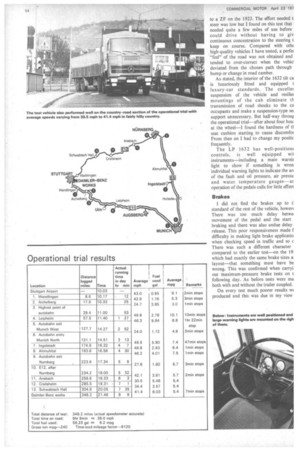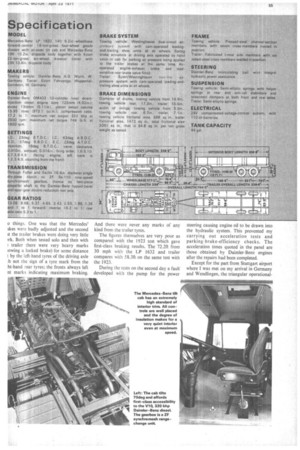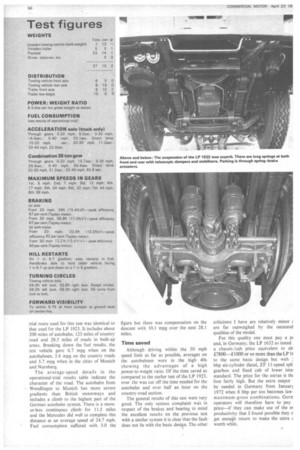Mercedes-Benz LP1632 Eylert 38-ton-gross combination
Page 55

Page 56

Page 57

Page 58

If you've noticed an error in this article please click here to report it so we can fix it.
by Tony Wilding, MIMechE, XCEPTIONAL QUIETNESS in the cab rid excellent suspension were the main, fitial impressions I received during a road :.st and operational trial of the lercedes-Benz LP 1632 which I carried out Germany just before Easter. This latest lercedes-Benz heavy four-wheel truck has 320 bhp VIO diesel and it was tested at 38 ms gross with an Eylert six-wheel drawbar .ailer over a 348.2-mile route.
Except for a few miles at the start, the in was identical to that used for a test at se same weight of the LP 1923 with 230 hp engine. And this test again disproved te idea that high power brings with it a :.rious worsening of fuel consumption. Illy 2.29ga1 more fuel were used with the 10 over the 8.3-mile shorter route making verall consumption 0.45 mpg worse with .2 mph for the test. But against this there as a big reduction in the time taken for the lurney-9hr 9min against I 1 hr 3min –though an increase in average speed from 2.3 mph to 38.0 mph.
This improved average speed was -oduced without increasing the general
running speed: every effort was made to make this test comparable with the first. On the autobahnen I kept within the legal maximum of 80 kph (50 mph) as far as possible although, because of the general character of the vehicle-quietness, smooth ride and ease of handling, this speed seemed like a crawl and it often crept up unnoticed to more than 90 kph (56 mph).
I said in the LP 1923 report that driving the vehicle had similarities with driving a car. Yet the LP 1632 is even better. It has been developed from the 1923 and has a tilt cab fitted. Externally, this unit is little different to the fixed cab but inside there have been big improvements. The standard of design and the quality of the interior trim and fittings are really superb and I have not seen anything better in a European truck.
With the 320 bhp VIO, a new ZF range change synchromesh gearbox is used. In addition to a four-speed main section and two-ratio secondary gearing, this has an ultra-low--13.09 to 1—"crawler" gear which, incidentally, provides a gradientclimbing ability with the V10 of 1 in 3.2 at 38 tons. So the box has nine overall ratios although the "crawler" will only be needed in exceptional circumstances. We never needed the lowest ratio on my test and restarts on the flat were satisfactory in third. After this the change sequence was fourth and fifth followed by a change in the range section (through a button on the gear lever) at the same time as returning to the bottom gear in the main part of the box to repeat the change pattern.
Gear change
While the choice of ratios was good I was not very impressed with the gear-change action. It was certainly not as good as that of the constant-mesh gearbox in the LP 1923. The engagement "slots" were not well defined—there was a "rubbery" feeling about the action and heavy baulking occurred particularly when engaging second and sixth gears (the same "slot") which I failed to manage on one or two occasions.
The power steering on the LP 1632 is through a Daimler-Benz box as compared
to a ZF on the 1923. The effort needed t steer was low but I found on this test that needed quite a few miles of use before could drive without having to giv continuous concentration to the steering t keep on course. Compared with oth( high-quality vehicles I have tested, a perfe( "feel" of the road was not obtained and tended to over-correct when the vehic' deviated from the chosen path through bump or change in road camber.
As stated, the interior of the 1632 tilt ca is luxuriously fitted and equipped t luxury-car standards. The excellet suspension of the vehicle and resiliei mountings of the cab eliminate
tltransmission of road shocks to the ca occupants and make a suspension-type se; support unnecessary. But half-way throug the operational trial-after about four hou at the wheel-I found the hardness of tl seat cushion starting to cause discomfoi From then on I had to change my positic frequently.
The LP 1632 has well-positiont controls, is well ecjuipped wii instruments-including a main warnit light to show if something is wron individual warning lights to indicate the an of the fault and oil pressure, air pressu and water temperature gauges--ar operation of the pedals calls for little effort Brakes I did not find the brakes up to t standard of the rest of the vehicle, howevi There was too much delay betwe movement of the pedal and the start braking and there was also undue delay release. This poor responsiveness made f difficulty in making light brake applicatio when checking speed in traffic and so c There was such a different character compared to the earlier test-on the 19 which had exactly the same brake sizes a layout-that something must have be wrong. This was confirmed when carryi out Maximum-pressure brake tests on t following day. As before tests were ma both with and without the trailer coupled.
On every test much poorer results w( produced and this was due in my view
o things. One was that the Mercedes' ikes were badly adjusted and the second tt the trailer brakes were doing very little irk. Both when tested solo and then with trailer there were very heavy marks owing a locked brake) for some distance I by the left-hand tyres of the driving axle -it not the sign of a tyre mark from the ht-hand rear tyres; the fronts always left at marks indicating maximum braking. And there were never any marks of any kind from the trailer tyres.
The figures themselves are very poor as compared with the 1923 test which gave first-class braking results. The 72.2ft from 30 mph with the LP 1632 and trailer compares with 58.311 on the same test with the 1923.
During the tests on the second day a fault' developed with the pump for the power
steering causing eng'ne oil to be drawn into the hydraulic system. This prevented my carrying out acceleration tests and parking-brake-efficiency checks. The acceleration times quoted in the panel are those obtained by Daimler-Benz engines after the repairs had been completed.
Except for the part from Stuttgart airport where I was met on my arrival in Germany and Wendlingen, the triangular operational
trial route used for this test was identical to that used for the LP 1923. It includes about 200 miles of autobahn, 123 miles of country road and 28.5 miles of roads in built-up areas. Breaking down the fuel results, the test vehicle gave 6.7 mpg when on the autobahnen, 5.6 mpg on the country roads and 5.7 mpg when in the cities of Munich and Nurnberg.
The average-speed details in the operational-trial results table indicate the character of the" road. The autobahn from Wendlingen to Munich has more severe gradients than British motorways and includes a climb to the highest part of the German autobahn system. There is a moreor-less continuous climb for 11.5 miles and the Mercedes did well to complete this distance at an average speed of 24.7 mph. Fuel consumption suffered with 3.0 the figure but there was compensation on the descent with 10.1 mpg over the next 28.1 miles.
Time saved
Although. driving within the 50 mph speed limit as far as possible, averages on the autobahnen were in the high 40s showing the advantages of a high power-to-weight ratio. Of the time saved as compared to the earlier test of the LP 1923, over Ihr was cut off the time needed for the autobahn and over half an hour on the country-road section.
The general results of this test were very good. The only serious complaint was in respect of the brakes and bearing in mind the excellent results on the previous test with a similar system it is clear that the fault, does not lie with the basic design. The other
criticisms I have are relatively minor are far outweighed by the outstand qualities of the model.
For this quality one must pay a pl and, in Germany, the LP 1632 as tested a chassis /cab price equivalent to ab £3800—£1000 or so more than the LP Ii to the same basic design but with : bhp six-cylinder diesel, ZF 11-speed spli gearbox and fixed cab of lower inta standard. The price for the extras is tip fore fairly high. But the extra output be needed in Germany from Januaq 1972 when 8 bhp per ton becomes law maximum-gross combinations. Gent operators will therefore have to pay price--if they can make use of the e] productivity that I found possible they r get enough return to make the extra c worth while.




























































































































